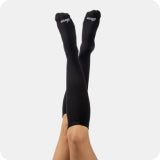Recognizing and Addressing Swollen Feet
Swollen feet, a common yet often overlooked discomfort, affects many of us. But don’t worry, there are practical ways to prevent and alleviate this issue. At Clove, we understand the daily demands placed on your feet, especially for those with jobs and responsibilities that have you constantly on the go. We’re here to empower you with knowledge and solutions, ensuring that your feet feel cared for and supported.
Recognizing Signs of Swollen Feet
Have you ever looked down at your feet and wondered, "Are my feet swelling?" or "How can you tell if your foot is swollen?" You’re not alone. Identifying swollen feet early on can make a significant difference in managing discomfort and preventing further complications. Here are the signs to look out for, each with a detailed explanation:
#1 Uneven Foot Size Comparison
Look at your feet side by side. If one appears larger than the other, this is a key indicator of a swollen foot. This visual assessment can quickly alert you to differences that might not be as noticeable at a glance.
#2 Shoe Fit Test
Pay attention to how your shoes fit. If they suddenly feel snugger or leave impressions on your skin at the end of the day, your feet may have a swollen ankle or swollen foot. This is especially common after periods of prolonged standing or sitting.
#3 Skin Indentation
Gently press on the swollen area with your thumb and hold for a few seconds. Suppose the skin retains a dent after you release the pressure. In that case, this indicates pitting edema, a type of foot and ankle swelling often associated with fluid retention or changes in blood pressure.
#4 Feel of the Swelling
Touch the swollen area to assess the texture. Swollen feet can feel unusually firm or spongy, giving you an idea of the severity and possible causes of the leg swelling.
By becoming familiar with these signs, you can take proactive steps to manage foot swelling effectively. Whether it's elevating your feet, adjusting your activity levels, or consulting with a healthcare provider, early recognition is your first line of defense.
Compared to Your Normal Foot Size
To get a clear picture, measuring the circumference of your ankle and comparing it to the other can be incredibly telling. This simple measurement can reveal asymmetries that might not be obvious at first glance. As previously mentioned, swollen feet often make shoes feel tighter than usual—a sure sign that it's time to address the swelling. Using a flexible tape measure, wrap it around the thickest part of your ankle and note the measurement. Do the same for the other ankle and compare the two.
If there's a noticeable difference, this could indicate swollen legs and/or swollen feet. Additionally, check how your socks and the ankles of your pants fit around each leg. If one side feels tighter or leaves deeper impressions in the skin than the other, this further confirms the presence of swelling. If you notice swollen feet after flying or have been standing all day and feel like your shoes seemingly don’t accommodate your feet as well as they usually do, consider these as your body’s signals calling for attention.
Understanding Symptoms and Sensations
Checking for swollen feet is not just being mindful of aesthetics, it is also being on alert for a range of symptoms and sensations that can affect your mobility and comfort. Here’s how to better understand and identify these symptoms:
Pain and Aching: The most immediate sensation you might notice with swollen feet is discomfort. Pain can vary from a dull ache to a throbbing sensation, often worsening with prolonged standing or towards the end of the day. This pain is your body signaling that something is amiss, and it shouldn’t be ignored.
Shiny, Stretched Skin: When swelling is present, the skin may look shiny and feel tight, almost as if it’s being stretched beyond its normal capacity. This is due to the skin accommodating the excess fluid buildup in the underlying tissues.
Color Changes: Keep an eye out for any color changes in the skin of your feet. Swelling can lead to a reddish, purplish, or bluish tint, indicating that blood flow may be affected. In some cases, the skin may also appear paler than usual if the swelling is severe.
Increased Footprint: When standing, your footprint may appear wider or deeper than usual if your feet are swollen. This can be a useful visual indicator to assess how much swelling is present.
Temperature Differences: Sometimes, swollen areas can feel warmer or cooler to the touch compared to other parts of the body. This temperature change can be a clue to the cause of swollen feet, such as inflammation or poor circulation.
Clove's Solutions for Foot Comfort
At Clove, we’ve poured extensive research and expert advice into designing sneakers and accessories that support anyone constantly upright and on the go. Our men’s sneakers and women’s sneakers are crafted for comfort, supporting you every step of the way so that swollen feet are one less worry as you go about your day.
Additionally, consider pairing your sneakers with our compression socks to help manage sudden swelling effectively. These compression socks are like a hug for your feet, aiding blood circulation and reducing fluid retention. Whether you’re dealing with swollen pregnancy feet, long hours on your feet at the job, or a medical condition, our socks offer a blend of comfort and style that keeps your well-being in check.
Swollen feet can stem from various causes. Recognizing the signs early and addressing them with the right footwear and practices can make a significant difference. Remember, getting rid of swollen feet is about adopting the right habits that help maintain your physical health and recognizing the instances when it's time to seek medical attention.
Sources:
- Health.com. 13 Causes of Swollen Feet and Ankles. https://www.health.com/condition/heart-failure/swollen-feet
- Harvard Health Publishing. What's causing swollen feet and ankles? https://www.health.harvard.edu/diseases-and-conditions/whats-causing-those-swollen-feet
- Medical News Today. Why are my feet swollen? https://www.health.harvard.edu/diseases-and-conditions/whats-causing-those-swollen-feet



